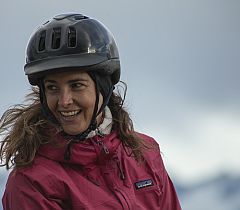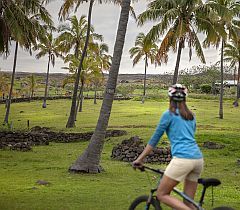Into the Wild: Patagonia Road Trip
By Jonathan Franklin
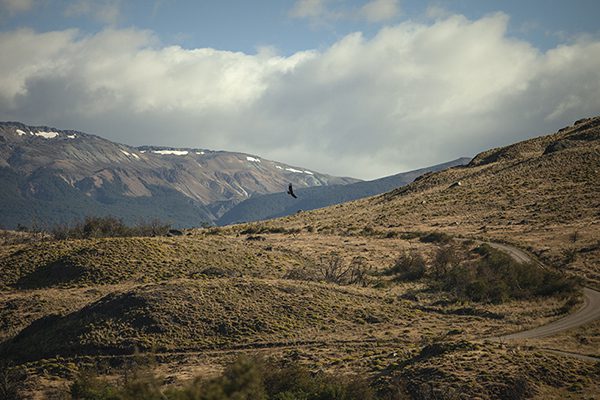
“Thwack, Thwack, Thwack” the lazy thud of a flat tire stops us cold. The tire is shredded by the rocky road and the lug bolts won’t budge. Climbing to the roof of the van–to unlatch our only spare tire and a few extra tools–there is not a car in sight, no houses nearby and no planes overhead. I notice a most unusual noise: an overwhelming silence.
Above me, a trio of Andean condor circle in search of a dead jackrabbit to dismantle or the leftovers from a mountain lion attack on a flock of sheep. The condors draft off the mountain ridge, gliding on wings a meter long, while I stare at the turquoise shades of the Baker River that froths by in a swirl of blues and greens provoked by minerals from the runoff of the Patagonia Icefields. We are stranded on the edge of Route 7, down the road from Patagonia National Park, a gigantic Chilean wildlife sanctuary inaugurated three years earlier and a secret oasis largely unknown to international travelers.
We’ve begun our trip in the northern city of Puerto Montt and driven nearly straight through thick forests, but a bad luck, 4-day rainstorm keeps us moving south with hardly a stop. This ends only when we are arriving near the city of Coyhaique a thousand kilometers south. It’s here I actually began to get to know my 2 travel companions, veteran photographer Tomas Munita, and 19-year-old guide Clemente Donoso. Near the banks of giant lake General Carrera as the sun rips out, we slow down to find our pace.
This is an area known as Aysen and only recently discovered. From the first Spanish conquistadores in the late 1500’s until the mid 1970’s almost no roads penetrated this forest. That all changed in 1986 when General Augusto Pinochet ordered the Chilean military to build a road through hundreds of miles of thick forest, snowy mountain passes and icefields around Caleta Tortel, the remote that for centuries was connected to the world only by ocean.
Pinochet poured money into Patagonia as he dispatched a brigade to hack the trees, dynamite the mountains and slice through the glaciers. A legion of soldiers and engineers arrived and set up a dozen base camps. They had, no electricity and generators that often died when wet. “It was actually impossible,” said Pedro Salazar, a retired Coronel in the Chilean Army. “When they asked foreign firms to participate in the bids to build the road, they all refused. They said it couldn’t be done.”
But Pinochet prevailed, his troops known as the Cuerpo Militar del Trabajo endured a Herculean task on par with Ferdinand de Lesseps’ construction of the Suez Canal. Over four decades, the construction of the Carretera Austral has continued in fits and starts. To this day, the route is incomplete. Washouts, rockslides, destroyed bridges and volcanic explosions guarantee that constant maintenance is necessary and discourages all but the hardiest travelers.
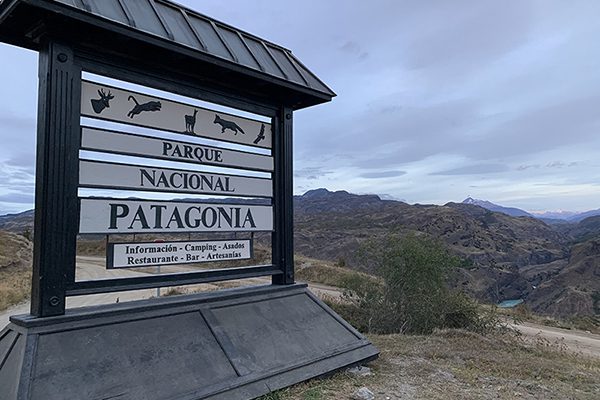
Digging into the gravel, then jacking up the van on this deserted road at the southern tip of South America I am closer to the South Pole than the Equator. After a year and half of restrictions it feels like a privilege to be changing the flat of our camper van in the wilds of Patagonia.
Continuing onward, we drive higher into the hills looking for the entrance to Patagonia National Park. A week of heavy rain drains down the hillsides in flashing white stripes that are visible from kilometers away. Up close, the cascading chutes of white spray pounds out a rhythm like a hundred drums as the water flows over boulder-strewn riverbeds, off the edge of a steep mountainside and splashes onto the road. I see not a single car and calculate that we are travelling at a rate of forty-seven waterfalls an hour.
In most parts of South America, road signs are few and far between, but Chile is a country obsessed with maps–not surprising given that the nation is essentially an island walled off from the world by the Atacama Desert to the north, the Andes Mountains to the east, the roaring Pacific Ocean to the west and bordered to the south by the newly designated Antarctic Ocean.
Here in Patagonia, Chile’s mapmakers were apparently overwhelmed by nature’s abundance. Dozens of road signs announce that we are about to cross the “The Bridge With No Name” which will then take us over the whirling waters that another road sign describes as “The River With No Name”. Unless you are a Chilean taxpayer, there is something beautifully absurd about a region that runs out of names for its waterways but still feels obliged to plant a metal signpost into a cement stand and assert human dominance over a landscape that, more often than not, has the final word.
At the entrance to Patagonia National Park, a galloping herd of wild beasts with the head of a camel and the sleek lines of a racehorse run full speed, across the road. The guanaco leap over boulders and bushes, then stop on a dime and munch prairie grasses returning to this valley that after 80 years as a sheep ranch has now been converted into a national park.
Two meters tall and living in massive herds, the guanaco once roamed Chile from north to south, preferring the pastures of the central valley which created such conflict with ranchers and farmers that entire flocks were slaughtered. Today the guanaco is found not in herds of thousands but only a few remaining pockets of protection–like here in the park where the population is estimated at sixteen hundred. They are skittish. I blame the big cats, the region’s apex predator, the 60-kilo mountain lion known locally as “los leones” or puma.
We scan the hills for signs of a mountain lion on the hunt. Lion spottings have soared this year–the pandemic drove away visitors and allowed the animals to reclaim traditional migration routes. As the sun sets, park employees round up their small children, adorn them with headlamps and enthusiastically cheer them on. “C’mon kids,” one dad chimes. “Let’s go find some mountain lions.”
Leaving the park, we stop to photograph a distant lake we are greeted by Humberto Verdugo, a wizened 74-year-old campesino, who walks slightly hunched forward as he approaches us, a barbed wire fence as mediator in between. Verdugo is backed by a pair of horses, a meager flock of sheep and a huge cart for hauling firewood. Verdugo then puffs his chest like a military man and invites us into his humble home.
Entering the two-room cottage above the town of Puerto Guadal is like travelling back in time. His simple home is overflowing with dignity. The barren shelves are separated. Half filled with neatly stacked boxes of tea the other with wine. Verdugo is fiercely independent, even makes his own medicines by coating carrots with burnt sugar for colds and keeping his spirits light with a daily dose of Mexican folk music. His long-time relationship is stable. Together with his horse Millay they have been together 34 years. His wife lives down the valley, and they seem content living independent of one another’s routines. This old settler rarely leaves his hillside. He’s content to have avoided ever visiting a city, a place he is certain that bandits “slit your throat” and authorities arbitrarily lock you up. The stories flow, as does the alcohol.
“Your timing is perfect!” Humberto announces, pulling a cardboard box of white wine just dropped off by his daughter, who lives in the valley below. Humberto firmly steadies a knife and slices the box open. He serves us each a shot glass of cold white wine. The knife returns to a leather case, hand sewn with long deliberate stitches.
Verdugo is a stickler for routines. His radio is set to Radio Penafquen which at 6am allows him to begin the day with Mexican rancheras–ballads of love, treachery, and hope. Every day, he tells us, his breakfast begins with white wine and ends with grilled lamb. He adds rice and potatoes as needed. Then hauling a wooden cart, the size of a pickup, he trudges uphill. There were years when he used a team of oxen, but no longer, so he hauls the wood out himself, which explains his rather hunched posture.
It wasn’t easy chopping down an entire forest by hand axe. But looking up at the denuded valley Humberto describes forty full years pulling out two cubic meters of firewood a day–which suggests he downed 45,000 trees. Informed of the toll he grins, “I could have done more.”
Don Humberto serves us a plate of grilled beef, boiled potatoes, and piles on extra portions of lamb or maybe beef, it’s impossible to know and rude to ask. All this gnawing takes a toll on a man’s mouth, Humberto says with a toothless smile. His upper deck is empty. Down below, a single tooth on each side stands firm, like goalposts. While we drink the faux Chardonnay, Verdugo carves up even more cold slabs of meat from a charred pan and I add a chunk of cheese to what is clearly a period of settling in. I am adapting to this pace of life celebrated by the region’s slogan: He who hurries in Patagonia, wastes his time.
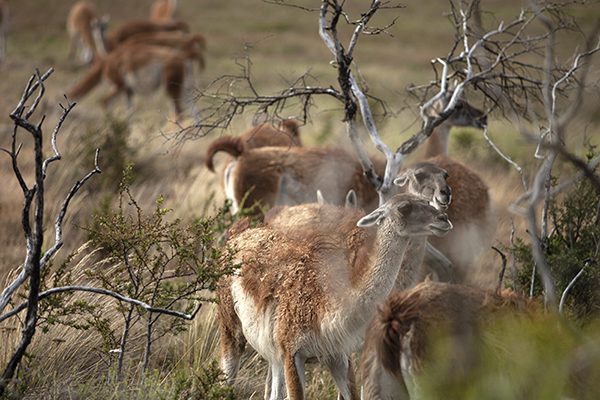
Leaving Humberto, we search for a stretch of shore along Lago Tranquilo to park the van and upon which to set our evening campsite. A beating rain clanks the metal roof and turns the road into slush. Forty kilometers per hour is a pace that seems to best fit our mood. As we look for a campsite, Tomas Munita is at the wheel is regaling Clementine (the 19-year-old who is the son of one of Tomas’ friends, shares a bunk next to me in the cramped van about his decade as a New York Times photographer including long stretches in Kandahar, Afghanistan. Tomas plays us his favorite Arab music as he explains how he used his severance pay from the Times to buy this Mercedes cargo van, which is now decked out with couches, pillows, a small kitchen, rooftop solar panels, a water filter and the ingenious carpentry usually found on sailing ships. Every nook is a shelf, plug, cabinet or drawer. For the next week this is our collective home.
As we finish dinner, the owner of the field comes to inspect us, the intruders. To lessen the tension, I immediately call out, “A coffee or a beer?” He smiles and declines both. He’s curious. Who is camping on his land? He asks that we not start any fires and use “good judgement.” Then he wishes us a good day and notes upon leaving that “in reality, no one owns the land.”
Sleep is elusive as I keep falling off the plank that is my bed. It doesn’t feel like suffering, as I absorb the soundtrack of a gurgling river and anticipate those precious sips of morning coffee. The first thing I see at morning, out the open door of the van, are two ducks swimming on a glistening lake. Snowy peaks mark the horizon. Frost dots the foreground–along with a pair of empty wine bottles. Washing the previous evening dishes in the frigid water my fingertips turn bright red then a darker purple. They ache from the cold in a way that is almost pleasurable. My brain is starting to reset as I venture into this wilderness.
Down the road from our campsite we drive north past the village of Lago Tranquilo and into Bahia Murta, on the northwest shores of Lago General Carrera, where we meet Clotilde del Carmen, 66, who has spent a half century scratching out a living at her family’s homey roadside business. She sells slices of fresh cake and her regionally famous meatballs with rice and salad. It’s a modest home that is surrounded by tenderly cultivated guardians antique farming tools and Residencial Patagonia, a cluster of rooms with solid roofs and clean beds for weary travelers.
Clotilde describes her grandfather arriving in 1924, or maybe it was 1926, but either way what he saw from his boat was unforgettable a “stain of green” he would later remark, an endless green splash that carpeted the hillsides, lined the valleys, and bordered the rivers as one vast, endless forest. This rain forest–not the tropical rainforests of the Amazon or Congo–is even more rare: a coastal temperate rainforest. Here the vegetation is three times as thick as the Amazon and the rain so incessant that old-timers remember entire months where the downpour never paused. These first settlers confronted a forest that was mixture of hardwoods with the gaps filled by a wall of impenetrable bamboo. Even experienced explorers with axes and machetes were barely able to penetrate a kilometer after a single day of exhausting hacking, chopping, and cursing.
To penetrate this wilderness, the settlers turned to an age-old technique–fire. At first it was small blazes, just enough to clear a patch for a house and a few cows. But by the early 1940’s rather than a series of small, controlled burns, swaths of the region erupted in a fire so intense that it burnt all year, even surviving the sodden winters to every spring erupt in life and then char its way through summer and fall.
Year after year, winter after winter, the embers glowed red, and the fields of summer were fields of flames that destroyed an estimated 4 million acres of hardwood forest. The inferno eliminated not only a mature forest but exposed the light coating of topsoil to heavy rains which washed it down the gulleys, into the rivers which–clogged with sediment–were quickly deprived of oxygen. The fish life soon died.
In the hikes and treks and drives over the past days, I saw burned stump after burned stump, reminders of this apocalypse. These great fires eventually created so much smoke that rural residents in South Africa were left to wonder at the arrival of an orange cloud that crossed first the Andes and then the Atlantic.
Clotilde was fierce in her defense of destroying the forest, saying, “If you don’t burn, you don’t populate.” And even after burning away much of the forest, she emphasized, life here is still harsh. Her family once bred dairy cows and delivered milk and, in the winter, sold cheese. Miners coming down from the hills and fishermen headed to sea were her customers, but the mine is closed–abandoned by its French owners in 1986–and the fish are nearly gone. With a rising environmental consciousness every year there are more new national parks and an emphasis on tourism not ranching. Many traditions and a way of life are ending and while Clotilde knows that more national parks and more tourists will bring jobs and visitors to her cabins, she can’t understand why no one works the land anymore. No oxen are tilling the field, she says, not even many tractors anymore.
The arrival of graded roads and new bridges brings trucks piled high with boxes of goods from afar: lemons, toilet paper and vegetables. Clotilde is aghast at these changes. Locals now buy their food instead of harvesting. The fields lay fallow and this new generation, she fears, is also failing to sprout. With indignation she exclaims, “They don’t even know how to plant potatoes!”
Letting Clotilde talk serves two purposes. Foremost, I am hearing the true story of how rugged frontier families first settled this wild land not long ago. And second, I am out of the van, able to stretch my legs and breathe the rain-soaked air of Patagonia which never fails to feel like a vitamin-infused refreshment. Sipping unbearably bad instant coffee and nibbling delicious toast with homemade marmalade, I began to understand why locals like Clotilde feel overwhelmed by all the changes, by the end of an era. Despite her pessimism, I believe her bleak view on the future of Patagonia are one dimensional. Yes, the old practices are dying off, but as I explore, I find another Patagonia arising from the ashes.
Small farms manned by young professionals fleeing Santiago far to the north are sprouting up. These folks, it is true, are not planting potatoes but they instead are well versed in organic gardening, drip irrigation, and techniques to use solar panels to heat greenhouses that now provide fresh tomatoes, lettuce, and veggies all year round. At “Huerto Cuatro Estaciones” on the shores of Lake General Carrera just north of Puerto Bertrand village, we stopped to interview Javier and Pancho, the owners, who have labored for years to construct cultivated organic fields that not only showcase an understanding of the fields but a love to protect them. These are folks likely to adopt vegan diets and who abhor hunting, making the clash with the older generations all too clear. While the original settlers celebrate rodeos and hunting wild pigs, these new arrivals are more interested in kayaking and fly fishing with a philosophy of “catch and release”.
Exploring up and down the Carretera Austral, I can’t help but notice this changing of the guard. Yes, the old ways are dying off but a flood of migrants into Patagonia bring a zeal to protect, to cherish and to treat the land with care. No doubt, more sheep will be devoured by puma and before too long a few humans as well. But after a century of abuse, it feels like a vast improvement for this wild land so stunning yet so vulnerable to human intervention. After a week in Patagonia, I’ve lost track whether it is Tuesday or Thursday and come to realize it doesn’t matter. I am free of those artificial constructs. Freed from the addiction to news, social media and the overwhelming avalanche of information that is a hallmark of this age. Happily, I must think long about when I last showered. I remind Clementine, the 19-year-old, that I came to the heart of Patagonia looking to disconnect. He scolds me. “Dude, you are coming here to connect. Why does your generation always say disconnect when they are talking about heading into nature?”
